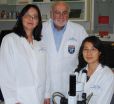INFORMATION:
Funding from the Sandy Slomin Foundation supported this research.
Other researchers involved in this study were Amanda Toland and Leigha Senter.
The Ohio State University Comprehensive Cancer Center – Arthur G. James Cancer Hospital and Richard J. Solove Research Institute strives to create a cancer-free world by integrating scientific research with excellence in education and patient-centered care, a strategy that leads to better methods of prevention, detection and treatment. Ohio State is one of only 41 National Cancer Institute (NCI)-designated Comprehensive Cancer Centers and one of only four centers funded by the NCI to conduct both phase I and phase II clinical trials. The NCI recently rated Ohio State's cancer program as "exceptional," the highest rating given by NCI survey teams. As the cancer program's 228-bed adult patient-care component, The James is a "Top Hospital" as named by the Leapfrog Group and one of the top cancer hospitals in the nation as ranked by U.S.News & World Report.
Study finds potential link between breast cancer genes and salivary gland cancer
2014-10-08
(Press-News.org) COLUMBUS, Ohio – The risk of developing cancer in a salivary gland might be higher in people with mutations in either of two genes associated with breast and ovarian cancer, according to a new study by researchers at The Ohio State University Comprehensive Cancer Center – Arthur G. James Cancer Hospital and Richard J. Solove Research Institute (OSUCCC – James).
Although salivary gland cancer is rare, this retrospective study suggests it occurs 17 times more often in people with inherited mutations in genes called BRCA1 and BRCA2, than those in the general population.
"Further study is needed to confirm this preliminary result, but I believe that a BRCA-positive patient with a lump in a salivary gland should have that lesion evaluated as soon as possible," says co-author Theodoros Teknos, MD, professor and chair of otolaryngology, director of head and neck oncologic surgery, and the David E. Schuller, MD, and Carole H. Schuller Chair in Otolaryngology at the OSUCCC – James.
The findings are published in the journal JAMA Otolaryngology-Head and Neck Surgery.
It is well known that women who inherit mutations in either of the two genes have a higher risk of breast and ovarian cancer than women without the mutation; men with the mutations are at higher risk of breast cancer. The two mutated genes are also linked to prostate, pancreatic and other cancers.
The study's principal investigator, Rebecca Nagy, MS, a certified genetic counselor and clinical associate professor of human cancer genetics at the OSUCCC – James, recommends that individuals who carry a BRCA mutation need to be made aware of this possible association.
"The finding should be considered during genetic counseling of families with inherited BRCA1 or BRCA2 mutations," says Nagy, who is also immediate past president of the National Society of Genetic Counselors. "In the future, patients with salivary-gland cancer and their family members might be referred for BRCA testing, or carriers of BRCA mutations might undergo surveillance for salivary gland cancers."
Cancers of the salivary glands are rare in the United States, with about three cases occurring annually per 100,000 adults in the general population (0.003 percent).
For this study, Nagy, Teknos, first-author and medical student Tim Shen and their colleagues searched a large BRCA-gene-mutation database maintained by the OSUCCC – James Clinical Cancer Genetics Program for salivary gland cancers. Out of 5,754 people with mutations in either the BRCA1 or BRCA2 gene, the researchers identified three cases of salivary gland cancer (0.052 percent).
"I would like physicians and dentists to realize that BRCA mutations carry risks for salivary gland cancer as well as breast cancer, and to remember that salivary glands include not only the paired parotid glands and submandibular glands but also innumerable minor salivary glands in the oral cavity," Teknos says.
ELSE PRESS RELEASES FROM THIS DATE:
Neuroscientists use snail research to help explain 'chemo brain'
2014-10-08
It is estimated that as many as half of patients taking cancer drugs experience a decrease in mental sharpness. While there have been many theories, what causes "chemo brain" has eluded scientists.
In an effort to solve this mystery, neuroscientists at The University of Texas Health Science Center at Houston (UTHealth) conducted an experiment in an animal memory model and their results point to a possible explanation. Findings appeared in The Journal of Neuroscience.
In the study involving a sea snail that shares many of the same memory mechanisms as humans and a drug ...
Mangroves protecting corals from climate change
2014-10-08
Certain types of corals, invertebrates of the sea that have been on Earth for millions of years, appear to have found a way to survive some of their most destructive threats by attaching to and growing under mangrove roots.
Scientists with the U.S. Geological Survey and Eckerd College recently published research on a newly discovered refuge for reef-building corals in mangrove habitats of the U.S. Virgin Islands. More than 30 species of reef corals were found growing in Hurricane Hole, a mangrove habitat within the Virgin Islands Coral Reef National Monument in St. John.
Corals ...
Study: Talking while driving safest with someone who can see what you see
2014-10-08
CHAMPAIGN, Ill. — A new study offers fresh insights into how talking on a cell phone or to a passenger while driving affects one's performance behind the wheel. The study used a driving simulator and videophone to assess how a driver's conversation partner influences safety on the road.
"We've done years of study on driver distraction, and previous studies suggest that passengers often aren't distracting. In fact, passengers can be helpful, especially if they're adults who have had experience and also are active drivers themselves," said University of Illinois psychology ...
Country's economy plays role in Internet file-sharing patterns
2014-10-08
Peer-to-peer file sharing of movies, television shows, music, books and other files over the Internet has grown rapidly worldwide as an alternative approach for people to get the digital content they want -- often illicitly. But, unlike the users of Amazon, Netflix and other commercial providers, little is known about users of peer-to-peer (P2P) systems because data is lacking.
Now, armed with an unprecedented amount of data on users of BitTorrent, a popular file-sharing system, a Northwestern University research team has discovered two interesting behavior patterns: ...
In a battle of brains, bigger isn't always better
2014-10-08
Cold Spring Harbor, NY – It's one of those ideas that seems to make perfect sense: the bigger the brain, the more intelligent the creature. While it is generally true, exceptions are becoming increasingly common. Yet the belief persists even among scientists. Most biologists, for example, assume that rats, with larger brains, are smarter than mice. Cold Spring Harbor Laboratory (CSHL) scientists now challenge this belief. They compared mice and rats and found very similar levels of intelligence, a result that could have powerful implications for researchers studying ...
Childhood psychological abuse as harmful as sexual or physical abuse
2014-10-08
WASHINGTON - Children who are emotionally abused and neglected face similar and sometimes worse mental health problems as children who are physically or sexually abused, yet psychological abuse is rarely addressed in prevention programs or in treating victims, according to a new study published by the American Psychological Association.
"Given the prevalence of childhood psychological abuse and the severity of harm to young victims, it should be at the forefront of mental health and social service training," said study lead author Joseph Spinazzola, PhD, of The Trauma ...
Scientists question fundamental theory about education of immune police
2014-10-08
AUGUSTA, Ga. – A fundamental theory about how our thymus educates our immune police appears to be wrong, scientists say.
It's known that stem cells come out of the bone marrow and travel to the tiny thymus gland behind the breastbone to learn to become one of two CD4T cell types: one leads an attack, the other keeps the peace.
One widely held concept of why they become one or the other is that, despite coming from the same neighborhood and going to the same school, they are exposed to different things in the thymus, said Dr. Leszek Ignatowicz, immunologist at ...
Timely Ebola information from Journal of Disaster Medicine & Public Health Preparedness
2014-10-08
Rockville, MD – The Society for Disaster Medicine and Public Health is committed to examining the details of individual disasters and public health crises. With the recent arrival of Ebola in the United States, the journal is launching a special issue on the virus. The journal will serve as an educated and authoritative voice on the virus, risk and threat level, potential of outbreak, preparation and response for the public and media.
The Journal of Disaster Medicine and Public Health Preparedness, began covering events in their entirety via special issues this ...
Robotic surgery: More complications, higher expense for some conditions
2014-10-08
NEW YORK, NY (October 8, 2014)—For benign gynecologic conditions, robot-assisted surgery involves more complications during surgery and may be significantly more expensive than conventional laparoscopic surgery, according to a study by researchers at Columbia University Medical Center (CUMC). The results were published online today in Obstetrics & Gynecology.
Robot-assisted surgery was first widely used for radical prostatectomy. For procedures such as prostatectomy, where there were previously no minimally invasive options, robot-assisted laparoscopy often offered ...
Trying to fool a kindergartner? Not so fast
2014-10-08
This news release is available in French. Montreal & Vancouver, October 8, 2014 — From the words for colours to how to tie a shoelace, kids have lots to learn — and for the most part, they depend on others to teach it to them.
But whether deliberately or inadvertently, other people sometimes misinform. So at what age can kids tell trustworthy teachers from confident tricksters?
A new study published in PLOS ONE by psychology researchers from Concordia University and the University of British Columbia shows that by the age of five, children become wary ...



